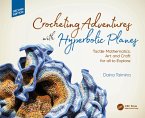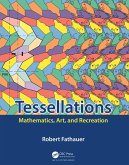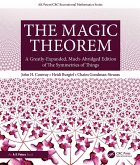Geometry for the Artist (eBook, ePUB)


Alle Infos zum eBook verschenken

Geometry for the Artist (eBook, ePUB)
- Format: ePub
- Merkliste
- Auf die Merkliste
- Bewerten Bewerten
- Teilen
- Produkt teilen
- Produkterinnerung
- Produkterinnerung

Hier können Sie sich einloggen

Bitte loggen Sie sich zunächst in Ihr Kundenkonto ein oder registrieren Sie sich bei bücher.de, um das eBook-Abo tolino select nutzen zu können.
Geometry for the Artist is based on a course of the same name which started in the 1980s at Maharishi International University. It is aimed both at artists willing to dive deeper into geometry and at mathematicians open to learning about applications of mathematics in art. The book includes topics such as perspective, symmetry, topology, fractals, curves, surfaces, and more. A key part of the book's approach is the analysis of art from a geometric point of view-looking at examples of how artists use each new topic. In addition, exercises encourage students to experiment in their own work with…mehr
- Geräte: eReader
- mit Kopierschutz
- eBook Hilfe
![The Secret World of Flexagons (eBook, ePUB) The Secret World of Flexagons (eBook, ePUB)]() Scott ShermanThe Secret World of Flexagons (eBook, ePUB)22,95 €
Scott ShermanThe Secret World of Flexagons (eBook, ePUB)22,95 €![Curved-Folding Origami Design (eBook, ePUB) Curved-Folding Origami Design (eBook, ePUB)]() Jun MitaniCurved-Folding Origami Design (eBook, ePUB)39,95 €
Jun MitaniCurved-Folding Origami Design (eBook, ePUB)39,95 €![Crocheting Adventures with Hyperbolic Planes (eBook, ePUB) Crocheting Adventures with Hyperbolic Planes (eBook, ePUB)]() Daina TaiminaCrocheting Adventures with Hyperbolic Planes (eBook, ePUB)27,95 €
Daina TaiminaCrocheting Adventures with Hyperbolic Planes (eBook, ePUB)27,95 €![Tessellations (eBook, ePUB) Tessellations (eBook, ePUB)]() Robert FathauerTessellations (eBook, ePUB)51,95 €
Robert FathauerTessellations (eBook, ePUB)51,95 €![Design Techniques for Origami Tessellations (eBook, ePUB) Design Techniques for Origami Tessellations (eBook, ePUB)]() Yohei YamamotoDesign Techniques for Origami Tessellations (eBook, ePUB)24,95 €
Yohei YamamotoDesign Techniques for Origami Tessellations (eBook, ePUB)24,95 €![An Invitation to Knot Theory (eBook, ePUB) An Invitation to Knot Theory (eBook, ePUB)]() Heather A. DyeAn Invitation to Knot Theory (eBook, ePUB)89,95 €
Heather A. DyeAn Invitation to Knot Theory (eBook, ePUB)89,95 €![The Magic Theorem (eBook, ePUB) The Magic Theorem (eBook, ePUB)]() John H. ConwayThe Magic Theorem (eBook, ePUB)22,95 €
John H. ConwayThe Magic Theorem (eBook, ePUB)22,95 €-
-
-
This book is an exceptional resource for students in a general-education mathematics course or teacher-education geometry course, and since many assignments involve writing about art, this text is ideal for a writing-intensive course. Moreover, this book will be enjoyed by anyone with an interest in connections between mathematics and art.
Features
- Abundant examples of artwork displayed in full color
- Suitable as a textbook for a general-education mathematics course or teacher-education geometry course
- Designed to be enjoyed by both artists and mathematicians
Dieser Download kann aus rechtlichen Gründen nur mit Rechnungsadresse in A, B, BG, CY, CZ, D, DK, EW, E, FIN, F, GR, HR, H, IRL, I, LT, L, LR, M, NL, PL, P, R, S, SLO, SK ausgeliefert werden.
- Produktdetails
- Verlag: Taylor & Francis eBooks
- Seitenzahl: 254
- Erscheinungstermin: 26. Mai 2023
- Englisch
- ISBN-13: 9781000876413
- Artikelnr.: 67717319
- Verlag: Taylor & Francis eBooks
- Seitenzahl: 254
- Erscheinungstermin: 26. Mai 2023
- Englisch
- ISBN-13: 9781000876413
- Artikelnr.: 67717319
- Herstellerkennzeichnung Die Herstellerinformationen sind derzeit nicht verfügbar.
Gorini edited Geometry at Work, published by the Mathematical Association of America, wrote the Facts on File Geometry Handbook, and has published journal articles in geometry, mathematics education, connections between mathematics and art, and the relationship between consciousness and mathematics. She is the executive editor of the International Journal of Mathematics and Consciousness and holds a PhD in mathematics from the University of Virginia in algebraic topology.
Analyze Art. 1.3. How to use this Book. Section II. Symmetry. 2. Symmetry.
2.1. The Nature of Symmetry. 2.2. Overview of Symmetry. 3. Finite Designs.
3.1. Symmetric Designs. 3.2. Symmetry Transformations. 3.3. Symmetries of a
Square. 3.4. Symmetries of a Pinwheel. 3.5. Leonardo's Theorem. 3.6.
Signature of a Symmetric Design. 3.7. Important Examples of Symmetric
Designs. 3.8. Compound or Layered Designs. 3.9. Symbols and Logos. 3.10.
Sacred Geometry. 3.11. Tips for Determining the Symmetries of a Design.
3.12. Creating Symmetric Designs. 4. Band Ornaments. 4.1. Overview. 4.2.
Symmetries of a Band. 4.3. The Seven Types of Band Ornaments. 4.4. The
Seven Types of Symmetries of Band Ornaments. 4.5. Making a Band Ornament of
Your Own. 5. The Regular Tilings. 5.1. Overview. 5.2. Translations of a
Tiling. 5.3. A Tiling by Squares. 5.4. A Tiling by Equilateral Triangles.
5.5. A Tiling by Regular Hexagons. 5.6. What We Have Learned about Regular
Tilings. 5.7. New Tilings from Old. 6. Tilings. 6.1. Overview. 6.2. Tilings
without Rotations-Four Tilings. 6.3. Tilings with Gyrations Only-Six
Tilings. 6.4. Tilings with Kaleidoscopes-Five New Tilings Plus Two Regular
Tilings. 6.5. Tips For Determining the Signature of a Tiling Pattern. 6.6.
Summary of Tilings. 7. Symmetry in The Work of MC Escher. 7.1. MC Escher's
Tilings. 7.2. How to Create Escher-Type Tilings. 7.3. Day and Night. 7.4.
Cycle. Section III. Perspective. 8. Introduction to Linear Perspective.
8.1. Overview. 8.2. Introduction to Linear Perspective. 8.3. The Geometry
of Linear Perspective. 8.4. The Central Vanishing Point. 8.5. Analysis of a
Perspective Picture. 8.6. How to Draw a Picture in One-Point Perspective.
8.7. Aerial or Atmospheric Perspective. 9. Drawing Grids in Perspective.
9.1. Overview. 9.2. Drawing a Square Grid in Perspective. 9.3. Where is the
Diagonal Vanishing Point? 9.4. Finding the Diagonal Vanishing Point in a
Painting. 9.5. Foreshortening Distances in a Perspective Painting. 9.6.
Using Grids to Draw Shapes in Perspective. 10. The Conic Sections. 10.1.
Overview. 10.2. The Conic Sections. 10.3. The Circle. 10.4. The Ellipse: A
Circle in Perspective. 10.5. The Parabola: A Fountain of Water. 10.6. The
Hyperbola: A Shadow on a Wall. 10.7. Drawing a Circle in Perspective. 11.
Two-Point and Three-Point Perspective. 11.1. Overview. 11.2. Two-Point
Perspective. 11.3. Esher's Cycle-An Example of Two-Point Perspective. 11.4.
Three-Point Perspective. 11.5. Using Two-Point and Three-Point Perspective.
12. Perspective in the Work of MC Escher. 12.1. Overview. 12.2. Relativity.
12.3. Belvedere. 12.4. Ascending and Descending. Section IV. Fractals. 13.
Proportion and Similarity. 13.1. Overview. 13.2. Congruent Figures. 13.3.
Similar Figures. 13.4. Congruence and Similarity in Art. 13.5. Important
Examples of Congruence and Similarity. 14. Fractals. 14.1. Overview. 14.2.
Constructing Geometric Fractals. 14.3. Natural Fractals. 14.4. Fractal
Dimension. 14.5. Applications OF Fractals. 15. Dynamical Systems and Chaos.
15.1. Overview. 15.2. Dynamical Systems. 15.3. Mathematical Dynamical
Systems. 15.4. Chaos. 15.5. Dynamical Systems and Chaos in Art. 15.6. Chaos
and Chance. 16. The Mandelbrot Set. 16.1. Overview. 16.2. The Complex
Numbers. 16.3. Graphing Complex Numbers. 16.4. Constructing the Mandelbrot
Set. 16.5. Properties of the Mandelbrot Set. Section V. Curves, Spaces, and
Geometries. 17. Lines and Curves. 17.1. Overview. 17.2. Straight Lines and
their Slopes. 17.3. Curves and Curvature. 17.4. Special Curves. 17.5. How
Artists Use Lines and Curves. 18. Surfaces. 18.1. Overview. 18.2. Surfaces.
18.3. Euclidean Geometry. 18.4. Elliptic Geometry. 18.5. Hyperbolic
Geometry. 18.6. The Three Geometries and Curvature. 18.7. The Three
Geometries around You. 19. Euclidean and Non-Euclidean Geometries. 19.1.
Overview. 19.2. Euclid's Postulates. 19.3. The Validity of Non-Euclidean
Geometries. 20. Topology. 20.1. Overview. 20.2. The Konigsberg Bridge
Problem. 20.3. Topology. 20.4. Topology in Art. 21. Pictorial Composition.
21.1. Overview. 21.2. Geometric Principles of Pictorial Composition. 21.3.
Portraits. 21.4. How The Eye Moves Around a Picture. 21.5. Understanding
Pictorial Composition. Bibliography. Appendix A. Suggestions for Final
Projects. A.1. Art Research Project. A.2. Art Research Team Project. A.3.
Creative Project. Appendix B. Answers to Selected Exercises. Index.
Analyze Art. 1.3. How to use this Book. Section II. Symmetry. 2. Symmetry.
2.1. The Nature of Symmetry. 2.2. Overview of Symmetry. 3. Finite Designs.
3.1. Symmetric Designs. 3.2. Symmetry Transformations. 3.3. Symmetries of a
Square. 3.4. Symmetries of a Pinwheel. 3.5. Leonardo's Theorem. 3.6.
Signature of a Symmetric Design. 3.7. Important Examples of Symmetric
Designs. 3.8. Compound or Layered Designs. 3.9. Symbols and Logos. 3.10.
Sacred Geometry. 3.11. Tips for Determining the Symmetries of a Design.
3.12. Creating Symmetric Designs. 4. Band Ornaments. 4.1. Overview. 4.2.
Symmetries of a Band. 4.3. The Seven Types of Band Ornaments. 4.4. The
Seven Types of Symmetries of Band Ornaments. 4.5. Making a Band Ornament of
Your Own. 5. The Regular Tilings. 5.1. Overview. 5.2. Translations of a
Tiling. 5.3. A Tiling by Squares. 5.4. A Tiling by Equilateral Triangles.
5.5. A Tiling by Regular Hexagons. 5.6. What We Have Learned about Regular
Tilings. 5.7. New Tilings from Old. 6. Tilings. 6.1. Overview. 6.2. Tilings
without Rotations-Four Tilings. 6.3. Tilings with Gyrations Only-Six
Tilings. 6.4. Tilings with Kaleidoscopes-Five New Tilings Plus Two Regular
Tilings. 6.5. Tips For Determining the Signature of a Tiling Pattern. 6.6.
Summary of Tilings. 7. Symmetry in The Work of MC Escher. 7.1. MC Escher's
Tilings. 7.2. How to Create Escher-Type Tilings. 7.3. Day and Night. 7.4.
Cycle. Section III. Perspective. 8. Introduction to Linear Perspective.
8.1. Overview. 8.2. Introduction to Linear Perspective. 8.3. The Geometry
of Linear Perspective. 8.4. The Central Vanishing Point. 8.5. Analysis of a
Perspective Picture. 8.6. How to Draw a Picture in One-Point Perspective.
8.7. Aerial or Atmospheric Perspective. 9. Drawing Grids in Perspective.
9.1. Overview. 9.2. Drawing a Square Grid in Perspective. 9.3. Where is the
Diagonal Vanishing Point? 9.4. Finding the Diagonal Vanishing Point in a
Painting. 9.5. Foreshortening Distances in a Perspective Painting. 9.6.
Using Grids to Draw Shapes in Perspective. 10. The Conic Sections. 10.1.
Overview. 10.2. The Conic Sections. 10.3. The Circle. 10.4. The Ellipse: A
Circle in Perspective. 10.5. The Parabola: A Fountain of Water. 10.6. The
Hyperbola: A Shadow on a Wall. 10.7. Drawing a Circle in Perspective. 11.
Two-Point and Three-Point Perspective. 11.1. Overview. 11.2. Two-Point
Perspective. 11.3. Esher's Cycle-An Example of Two-Point Perspective. 11.4.
Three-Point Perspective. 11.5. Using Two-Point and Three-Point Perspective.
12. Perspective in the Work of MC Escher. 12.1. Overview. 12.2. Relativity.
12.3. Belvedere. 12.4. Ascending and Descending. Section IV. Fractals. 13.
Proportion and Similarity. 13.1. Overview. 13.2. Congruent Figures. 13.3.
Similar Figures. 13.4. Congruence and Similarity in Art. 13.5. Important
Examples of Congruence and Similarity. 14. Fractals. 14.1. Overview. 14.2.
Constructing Geometric Fractals. 14.3. Natural Fractals. 14.4. Fractal
Dimension. 14.5. Applications OF Fractals. 15. Dynamical Systems and Chaos.
15.1. Overview. 15.2. Dynamical Systems. 15.3. Mathematical Dynamical
Systems. 15.4. Chaos. 15.5. Dynamical Systems and Chaos in Art. 15.6. Chaos
and Chance. 16. The Mandelbrot Set. 16.1. Overview. 16.2. The Complex
Numbers. 16.3. Graphing Complex Numbers. 16.4. Constructing the Mandelbrot
Set. 16.5. Properties of the Mandelbrot Set. Section V. Curves, Spaces, and
Geometries. 17. Lines and Curves. 17.1. Overview. 17.2. Straight Lines and
their Slopes. 17.3. Curves and Curvature. 17.4. Special Curves. 17.5. How
Artists Use Lines and Curves. 18. Surfaces. 18.1. Overview. 18.2. Surfaces.
18.3. Euclidean Geometry. 18.4. Elliptic Geometry. 18.5. Hyperbolic
Geometry. 18.6. The Three Geometries and Curvature. 18.7. The Three
Geometries around You. 19. Euclidean and Non-Euclidean Geometries. 19.1.
Overview. 19.2. Euclid's Postulates. 19.3. The Validity of Non-Euclidean
Geometries. 20. Topology. 20.1. Overview. 20.2. The Konigsberg Bridge
Problem. 20.3. Topology. 20.4. Topology in Art. 21. Pictorial Composition.
21.1. Overview. 21.2. Geometric Principles of Pictorial Composition. 21.3.
Portraits. 21.4. How The Eye Moves Around a Picture. 21.5. Understanding
Pictorial Composition. Bibliography. Appendix A. Suggestions for Final
Projects. A.1. Art Research Project. A.2. Art Research Team Project. A.3.
Creative Project. Appendix B. Answers to Selected Exercises. Index.







